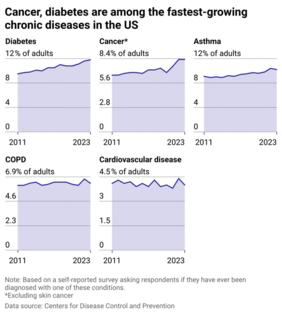Diabetes and other chronic conditions are becoming common. Here's how public health efforts can help bring rates down.
Published in Slideshow World
Subscribe
Diabetes and other chronic conditions are becoming common. Here's how public health efforts can help bring rates down.
As people live longer, a growing percentage of the population is living with, and dying from, chronic diseases.
Chronic diseases tend to require consistent medical attention and often restrict daily activity. The ongoing pain, limited mobility, compromised energy, and repeated treatments often associated with chronic diseases can be exhausting—and expensive—for those affected and their caregivers.
At least 43 million people worldwide died in 2021 from a noncommunicable disease, also known as a chronic disease, equivalent to 3 in 4 non-COVID-19 pandemic deaths globally that year, according to the World Health Organization. Those rates, both in the United States and abroad, continue to rise.
There's no single cause of chronic diseases, which typically last for 12 months or longer. An unhealthy diet, smoking, harmful alcohol usage, and a lack of exercise all contribute to rising rates of chronic ailments. These lifestyle factors are only compounded by environmental issues and social determinants of health; together, they put many individuals at acute risk for chronic disease.
Air pollution, for instance, is the largest environmental killer, according to the WHO. Annually, it accounts for 6.7 deaths around the world due to bad air, about 5.6 million of which were NCDs, such as asthma, chronic obstructive pulmonary disease, and lung cancer.
Typically, chronic diseases are grouped into four major categories: cardiovascular diseases, such as heart attacks and strokes; cancers; diabetes; and chronic respiratory diseases, such as chronic obstructive pulmonary disease, or COPD, and asthma. Rates of each group have risen in the U.S. in the past decade, except for cardiovascular disease. However, the latter remains the most prevalent, and rates have held steady, according to the Centers for Disease Control and Prevention.
These four disease groups account for 4 out of 5 premature deaths, or before the average age of death within a given population—in the U.S., deaths before age 75 are considered premature. Globally, these diseases are the leading cause of death before age 70.
Although chronic diseases affect people of all ages, older adults are more vulnerable to them. In particular, certain ailments like heart disease, Type 2 diabetes, kidney disease, and some cancers are more prevalent among older adults as the body's immunity decreases, and other underlying conditions contribute to their rise.
Dialysis Centers used data from the Centers for Disease Control and Prevention to examine the prevalence of NCDs in the U.S.
Visit thestacker.com for similar lists and stories.
Mitigating chronic disease
Diabetes is the fastest-growing chronic disease in the U.S., affecting roughly 12% of American adults and counted as the eighth leading cause of death, according to CDC data. Globally, it accounted for over 2 million deaths.
Surging rates of diabetes and high blood pressure have led to rising rates of kidney disease. This chronic condition progresses over time and eventually requires dialysis or a kidney transplant. As of 2024, 1 in 7 Americans were affected by chronic kidney disease, with non-Hispanic Black Americans experiencing this painful condition at nearly twice the rate of white Americans, according to Yale Medicine.
Dr. Randy Luciano, a nephrologist at Yale Medicine, said that cases of CKD are "multifactorial" and may include access to affordable care and medicine. "And minority populations are more likely to have diabetes, heart disease, high blood pressure, and obesity, all conditions that raise the risk for CKD," he told Yale Medicine.
Among chronic diseases, cardiovascular ailments take the most lives, accounting for at least 19 million deaths globally in 2021, per a 2024 WHO report. Cancers were the second most deadly, followed by chronic respiratory diseases, leading to 10 million and 4 million deaths, respectively.
Disparities in health outcomes
However, chronic diseases vary based on age, location, and other risk factors. Asthma, which causes airways to narrow and restricts breathing, is the most common chronic disease in children. Numerous studies have linked the rise in asthma with worsening air quality and air pollution, especially in low- and middle-income countries. A 2023 study published in the journal The Lancet Planetary Health found a link between specific air pollutants and asthma attacks among children in low-income urban areas. With 30 million new cases each year, asthma affects about 4% of the global population.
Other chronic diseases on the rise have concerned researchers, especially increases in cancer rates among younger people. The growing cases of obesity might be associated with a rise in risk for certain cancers, including alarming increases in young adults before age 40, according to a 2023 study in the journal Nature Communications.
Obesity and sedentary lifestyles can also help explain the sharp rise in Type 2 diabetes across the U.S. and globally over the past decade. In 2021, the CDC reported that 38.4 million Americans had been diagnosed with diabetes. There's a strong connection between poverty and diabetes, with low- and middle-income countries and individuals disproportionately affected.
Turning around current trends in chronic disease will require change on both individual and systemic levels. In his keynote address at the 2024 American Diabetes Association conference in Orlando, Florida, last June, Food and Drug Administration Commissioner Dr. Robert Califf said that lifestyle and nutrition interventions, as well as a more robust public health policy, were needed to slow the rapid growth of chronic health disease.
Public health solutions for chronic disease
"U.S. health outcomes are currently deteriorating," Califf said, as reported by the diaTribe Foundation. Noting that 2 in 5 Americans have at least one chronic health condition—and that many have multiple—Califf called the stark rise in Type 2 diabetes an "epidemic."
However, there are bright spots. Public health efforts to slow chronic disease rates have focused on addressing nonmedical factors that influence a person's health and wellness, also known as social determinants of health.
The CDC, for example, has invested in clinics in lower-income communities to help increase screenings and preventive care and support greater access to healthy food infood deserts, or areas that lack access to affordable, high-quality foods. Limiting reliance on ultra-processed foods, which have been found to contribute to diabetes and heart disease, while providing healthier options is critical to curbing risk factors.
Financial incentives can also help curb unhealthy behaviors. A 2023 study by researchers at the University of California, San Francisco, found that increasing taxes on cigarettes to support anti-smoking campaigns has yielded lower health care costs in the Golden State.
As it stands, most Americans consume more added sugar and saturated fat than recommended in their daily diets. "This is not a very good track record, despite all the effort and knowledge we have," Califf noted.
However, with the CDC's Healthy People 2030 initiative devoted to increasing health equity and a renewed focus on wellness in 2025, there's hope that America's health will turn a corner.
Story editing by Alizah Salario. Copy editing by Paris Close. Photo selection by Ania Antecka.
This story originally appeared on Dialysis Centers and was produced and distributed in partnership with Stacker Studio.








Comments